The most effective plant-based stabilizers for your essential oil perfumes include benzoin, frankincense, myrrh, and orris root as your foundation fixatives. You'll get excellent longevity from patchouli, vetiver, clary sage, and labdanum, while styrax and vanilla absolute round out your top options. For best results, blend these natural fixatives at 3-5% concentration using the classic 3:5:2 ratio for top, middle, and base notes. Discover how these time-tested botanicals can transform your fleeting fragrances into lasting signature scents.
The Time-Tested Power of Benzoin in Natural Perfumery
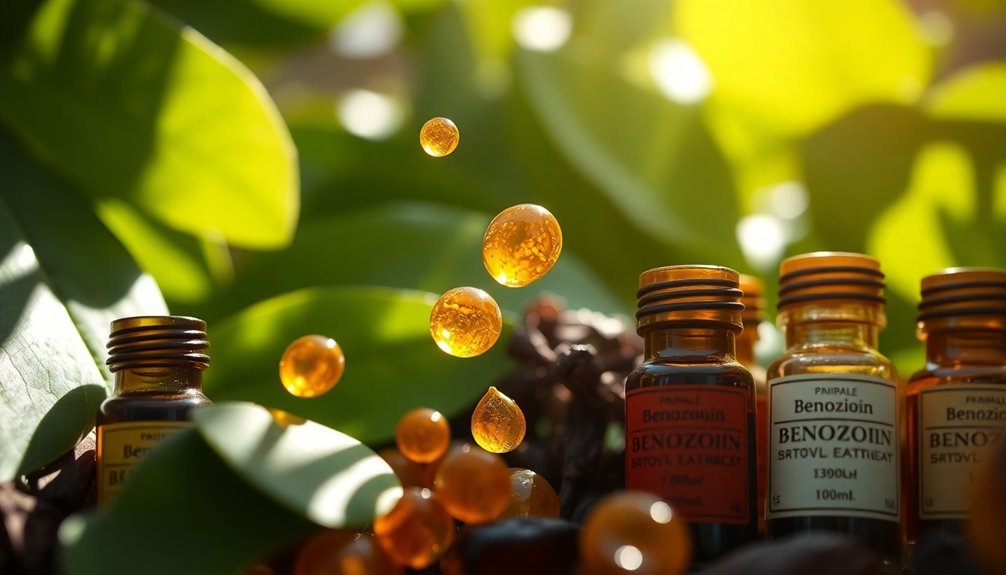
Benzoin, a precious resin from Styrax trees, stands as one of natural perfumery's most versatile stabilizers. You'll find this remarkable substance quietly working in many of your favorite natural fragrances, helping to lock in their scents for longer wear.
When you're crafting natural perfumes, you'll appreciate benzoin's dual role as both a fixative and an aromatic ingredient. Its rich, vanilla-like aroma with subtle spicy undertones complements essential oils like cardamom, frankincense, and sandalwood, while its fixative properties slow down the evaporation of other fragrance components. The resin performs exceptionally well with bergamot and lavender families.
You'll need to be mindful of proportions though – too much benzoin can overpower other scents.
For best results, dissolve benzoin in alcohol or use heat to incorporate it into oils, being careful to adjust quantities to prevent unwanted discoloration.
Frankincense: Ancient Wisdom for Modern Fragrance Stability
A timeless gift from the Boswellia trees, frankincense brings both ancient wisdom and modern science to natural perfumery.
You'll find its rich, woody aroma with hints of citrus and spice serving as an exceptional base note in your perfume compositions.
What makes frankincense particularly valuable is its dual role as both a natural fixative and antimicrobial agent. The product's 5.00 customer rating confirms its effectiveness in modern applications.
When you're crafting natural perfumes, these properties help stabilize your fragrance while naturally preserving the blend.
You'll notice your scents last longer and maintain their integrity over time.
Beyond its practical benefits, you're tapping into centuries of therapeutic and spiritual wisdom when you work with frankincense.
It's no coincidence that this resin has been prized in ceremonies and traditional medicine – its grounding properties and versatile aromatic profile make it an indispensable tool in modern natural perfumery.
Unlocking the Fixative Properties of Precious Myrrh
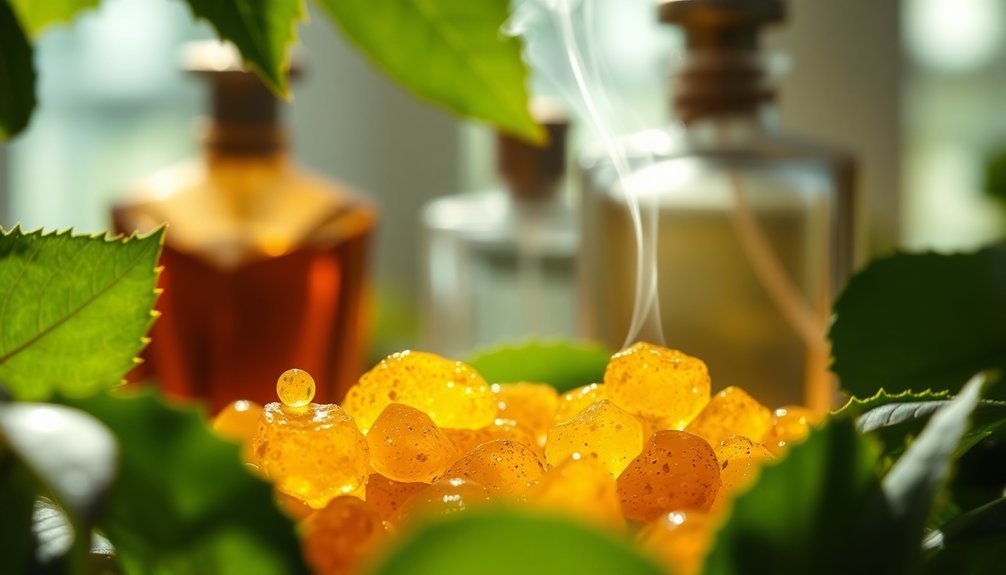
You'll find that myrrh's trade routes, stretching from ancient Arabia to Mediterranean ports, helped establish it as one of perfumery's most treasured fixatives.
Through modern steam distillation and solvent extraction methods, you can obtain myrrh's potent aromatic compounds that provide exceptional stability to fragrances. The resin's deep warm notes add richness while effectively slowing the evaporation of volatile components.
You can now harness myrrh's fixative properties in contemporary perfumery, where it serves as a natural stabilizer in luxury fragrances and botanical perfumes at an ideal 3-5% concentration.
Historical Myrrh Trade Routes
Throughout ancient history, the coveted myrrh resin traveled along an intricate network of trade routes known as the Incense Route, connecting Arabia to the Mediterranean world.
Starting in Shabwah, Hadhramaut, these routes stretched through sixty-five stages where camels would rest, running about 100 miles inland from the Red Sea coast.
You'll find that southern Arabia, particularly the Dhofar mountains, and northern Somalia were the primary sources of this precious resin.
Merchants transported myrrh in leather bags via camel caravans, with costs reaching 688 denarii per camel before reaching Mediterranean shores.
The trade route split at Dedan, branching toward Mesopotamia, Petra, and Gaza.
This lucrative commerce made South Arabian merchants incredibly wealthy, though they paid substantial taxes and tolls along the way, especially to Roman customs officers.
Optimal Myrrh Extraction Methods
When extracting myrrh's precious compounds, proper harvesting and preparation of the resin lay the foundation for successful processing.
You'll need to collect hardened resin from careful incisions in the Commiphora tree's bark, then grind it into a fine powder for ideal extraction.
You've got two main methods to choose from: steam distillation and solvent extraction.
Steam distillation will give you a pure essential oil with earthy, balsamic notes, while solvent extraction using hexane or ethanol produces a concentrated absolute with intense, lasting properties.
For perfumery purposes, both forms excel as natural fixatives.
You'll find they slow down the evaporation of other fragrance components and add remarkable depth to your compositions, especially in oriental and incense-inspired blends.
Modern Applications for Myrrh
Modern perfumery has embraced myrrh's extraordinary fixative properties, making it indispensable in creating long-lasting fragrances. You'll find this precious resin anchoring volatile ingredients and equalizing vapor pressures in luxury perfumes like Serge Lutens' La Myrrhe and Giorgio Armani's Imperial Myrrh.
When you're looking to create depth in your essential oil blends, myrrh excels at partnering with exotic ingredients like spices, woods, amber, and florals. You can combine it with benzoin and tonka bean for enchanting base notes, or let it stand alone as a top note.
While it can be challenging to blend, myrrh's unique ability to slow down evaporation rates makes it perfect for oriental and incense-inspired fragrances. It's particularly effective in sensual perfumes, where its warm, sweet characteristics enhance the overall composition's longevity.
Orrisroot: Nature's Answer to Fragrance Longevity
You'll find orris root's remarkable journey from ancient Egypt to modern perfumery reflects its enduring status as nature's premier fragrance stabilizer.
The intensive seven-year process of growing, drying, and extracting orris butter yields one of perfumery's most precious ingredients, requiring over a ton of rhizomes to produce just one pound of absolute.
When you're working with essential oils, orris root's fixative properties help anchor volatile scents while adding its signature powdery, violet-like notes that blend beautifully with woody and floral accords.
Historical Orris Root Uses
Ancient civilizations prized orris root for its seductive aroma and profound cultural significance.
You'll find its historical footprint stretching from Mediterranean regions to Japan, where it served multiple purposes beyond perfumery.
The versatility of orris root is particularly evident in these key historical applications:
- Medicinal treatments for various ailments, including bronchitis, colds, and toothaches
- Culinary uses in North African spice blends and gin production
- Spiritual practices, from Japanese evil spirit protection to love-drawing rituals
Florence became especially renowned for iris cultivation, incorporating the flower into its ancient arms.
When Coco Chanel launched her iconic Chanel No. 5 in 1921, she continued this rich tradition by featuring orris root as a key ingredient, cementing its status in modern perfumery.
Processing and Extraction Methods
Before orrisroot can work its magic as a natural fixative, it must undergo a meticulous transformation from raw root to refined extract.
You'll need to harvest the iris roots after three years of growth, when they've accumulated prime oil content. After thorough drying and grinding, some producers age the roots to enhance their fragrant properties.
The extraction process offers several methods, with steam distillation and solvent extraction being the most common.
You'll find that CO2 extraction provides superior results, preserving the delicate compounds while maximizing yield.
During processing, the root's irisin converts to irone, creating that distinctive sweet, powdery aroma.
The final extract contains essential oleoresins and volatile compounds that make orrisroot such an effective stabilizer in your natural perfume formulations.
Blending With Essential Oils
When crafting natural perfumes, orrisroot serves as a masterful fixative that extends the life of essential oil blends while contributing its own subtle, powdery notes.
You'll find it particularly effective when used at a 3-5% concentration in your base notes, where it harmonizes beautifully with both earthy and resinous elements.
For ideal results in your blending process, follow these key steps:
- Start by combining orrisroot with grounding oils like patchouli or vetiver.
- Layer in natural resins such as labdanum or benzoin for added warmth.
- Finally, balance with your chosen top notes, allowing orrisroot to anchor them.
You'll notice how orrisroot works synergistically with other natural fixatives like vanilla and sandalwood, creating complex, enduring fragrances that evolve gracefully on the skin rather than dissipating quickly.
Clary Sage: The Sustainable Alternative to Ambergris
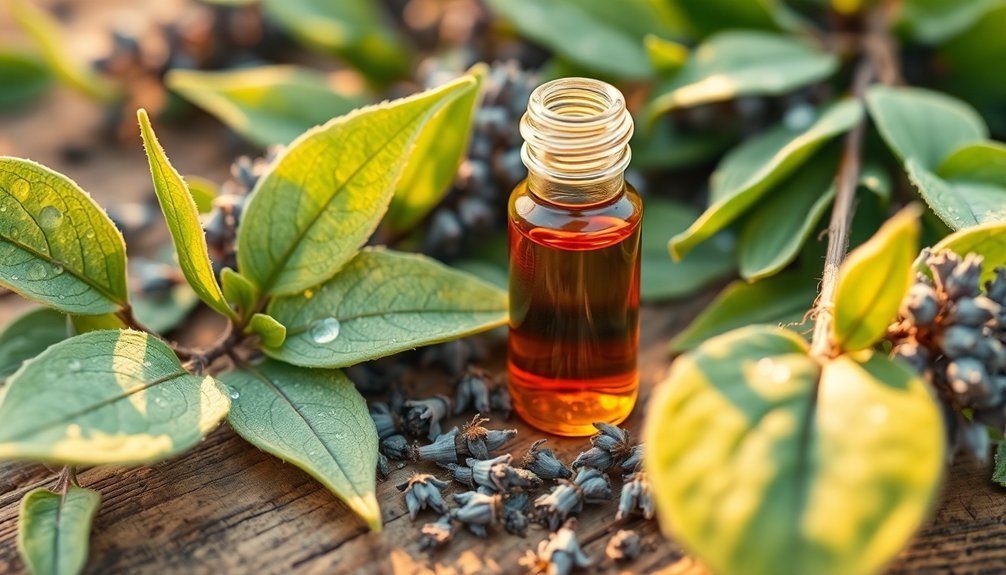
Modern perfumery's shift toward sustainable ingredients has brought clary sage into the spotlight as a plant-based fixative alternative to ambergris.
You'll find this herbaceous plant offers unique stabilizing properties that help your perfumes last longer while adding depth and complexity to your blends.
While clary sage won't replicate ambergris's distinct aroma, it excels at slowing down the evaporation of volatile compounds and anchoring scents to your skin.
You can use it as both an accent and base note, starting with small amounts to test how it interacts with other components.
When you're creating natural perfumes, you'll appreciate its versatility in floral, woody, and oriental compositions.
Beyond its fixative properties, you'll benefit from clary sage's anti-inflammatory qualities and its ability to enhance the harmonious diffusion of fragrances.
Essential Oils Blending With Plant-Based Stabilizers
When you're crafting essential oil blends with plant-based stabilizers, start with the classic 3:5:2 ratio of top, middle, and base notes while incorporating natural fixatives like frankincense or benzoin at 3-5% concentration.
You'll want to select stabilizers that complement your blend's therapeutic properties and aromatic profile, testing compatibility on perfume strips before finalizing your formula.
Begin with small test batches, adjusting drop by drop until you achieve the perfect balance between the essential oils and your chosen plant-based stabilizer.
Blending Ratios and Proportions
Although creating the perfect essential oil blend requires careful consideration, understanding the basic ratios and proportions serves as your foundation for success.
You'll find that the 3:5:2 ratio (top:middle:base notes) works well as a starting point for most blends. When working with a 20-drop formula, this translates to 6 drops of top notes, 10 drops of middle notes, and 4 drops of base notes.
For best results in your essential oil blending, follow these key steps:
- Start with a 1:1:1 ratio for simple blends
- Test your blend on perfume strips before mixing larger quantities
- Document successful ratios for future reference
Remember to incorporate carrier oils at a 1-3% dilution rate to stabilize your blend and guarantee skin safety.
You'll want to adjust these ratios based on your desired aroma strength and lasting power.
Natural Fixative Selection Guide
Selecting the right natural fixatives serves as a cornerstone in creating long-lasting essential oil perfumes. For citrus and floral blends, you'll want to choose resinous fixatives like frankincense or labdanum to anchor the lighter notes.
When working with oriental fragrances, consider using benzoin or myrrh for their warm, rich properties.
If you're crafting woody scents, patchouli and vetiver will provide excellent stability while adding earthy depth. For gourmand compositions, styrax and benzoin work wonderfully to enhance longevity and add warmth.
Sandalwood proves versatile across multiple fragrance families, particularly with florals and orientals.
Remember to match your fixative's therapeutic properties with your blend's intended effect – use calming cedarwood for relaxing scents, or uplifting frankincense for energizing formulations.
Stabilizer Compatibility Testing
Before blending essential oils with plant-based stabilizers, you'll need to conduct extensive compatibility testing to guarantee peak performance and longevity.
Start by evaluating the organoleptic properties to confirm your stabilizer won't compromise the blend's appearance, color, or fragrance.
For thorough testing, follow these critical steps:
- Monitor pH and density changes over time to verify chemical stability.
- Test microbiological resistance by checking for potential contamination growth.
- Assess container compatibility with different packaging materials to prevent leaching.
You'll want to experiment with different ratios of cereal extracts and essential oils, particularly those rich in natural antioxidants.
Remember to group your blends by scent families and consider evaporation rates when testing.
Always store your test samples under controlled temperature and light conditions to maintain accuracy throughout the testing period.
Mastering the Art of Natural Fixative Ratios
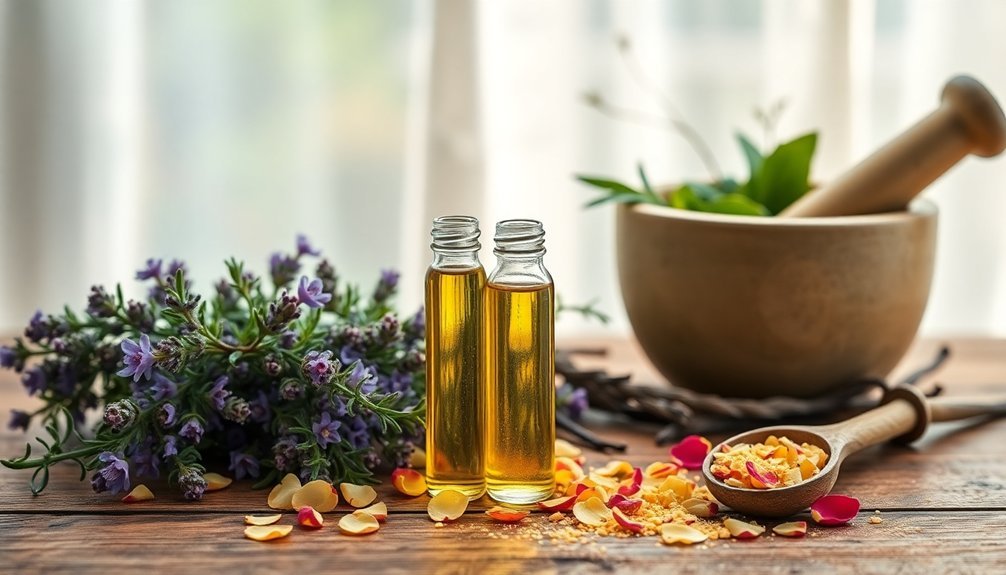
When crafting natural perfumes, understanding fixative ratios stands as a crucial cornerstone of successful formulation.
You'll want to start with a conservative approach, using fixatives at 3-5% of your total composition. For instance, in a 30ml fragrance oil blend, you'd incorporate about 10ml of fixatives alongside other components.
To scale up your formulations effectively, you'll need to multiply each ingredient by the same factor while maintaining proper proportions.
Focus on balancing your base notes, where fixatives primarily reside, at 15-30% of the total composition. You can experiment with natural fixatives like benzoin, labdanum, or sandalwood, but remember to document each trial carefully.
For beginners, it's best to work with 3-9 oils total to maintain simplicity and control over your creation.
Top Natural Resinoids for DIY Perfume Making
Natural resinoids serve as the backbone of DIY perfume making, offering both aromatic depth and staying power to your creations.
When crafting your signature scent, you'll find that resinoids like frankincense, benzoin, and myrrh work as exceptional fixatives while contributing rich, balsamic undertones.
For ideal results in your DIY perfumes, focus on these proven resinoids:
- Labdanum – Creates a deep amber base and extends fragrance longevity
- Benzoin – Adds sweet, vanilla-like notes while stabilizing other scents
- Frankincense – Provides ethereal depth and superior fixing properties
You can enhance your perfume's complexity by pairing these resinoids with complementary middle and top notes.
Whether you're aiming for an oriental blend or a fresh botanical scent, these natural stabilizers will guarantee your fragrance maintains its integrity throughout the day.
Creating Balanced Base Notes With Botanical Stabilizers

Successfully balancing base notes in botanical perfumery requires a strategic approach to stabilizer selection and proportions.
You'll want to focus on natural fixatives like labdanum and muskwood that bind scent molecules while adding depth to your fragrance profile.
Start by incorporating long-lasting botanicals such as sandalwood, patchouli, or vanilla as your foundation. These ingredients naturally extend your perfume's longevity without synthetic additives.
When you're blending, use fragrance test strips to evaluate how your stabilizers interact with other notes – you don't want them to overpower your composition.
Remember to source your botanicals ethically and sustainably.
Whether you're using SD alcohol or natural propanediol as your base, guarantee each ingredient contributes to both stability and aromatic harmony.
This careful balance will help create a clean-label perfume that maintains its integrity throughout wear.
Understanding Vapor Pressure in Natural Perfumery
Understanding vapor pressure proves essential for creating lasting natural fragrances since it directly influences how quickly your scent molecules evaporate.
You'll find that compounds with low vapor pressure (LVPVOCs) last longer on the skin, making them ideal stabilizers for your natural perfumes.
When formulating your botanical fragrances, consider these key vapor pressure factors:
- Use up to 80% LVPVOCs by weight to control evaporation
- Include potentiator compounds like esters and aldehydes
- Balance with higher volatility components for a complete profile
You can enhance your fragrance's longevity by incorporating natural materials known for slow evaporation rates.
Plant-based compounds with vapor pressure below 0.1 mm Hg at 20°C will help maintain your fragrance's integrity over time, while maturation processes allow the oils to develop fuller, more stable scent profiles.
Frequently Asked Questions
Can Plant-Based Stabilizers Cause Allergic Reactions When Used in Perfumes?
Yes, you can experience allergic reactions from plant-based stabilizers in perfumes. They'll trigger symptoms like contact dermatitis, pigmented reactions, and urticaria through direct application, airborne exposure, or indirect contact.
How Long Can Natural Perfumes Last When Stored With Plant-Based Stabilizers?
When you store your natural perfumes with plant-based stabilizers like benzoin or myrrh, they'll typically last 1-3 years if opened, and up to 5 years unopened. Keep them in cool, dark places for best results.
Do Plant-Based Stabilizers Change Color or Texture Over Time?
Yes, you'll notice your plant-based stabilizers can change color through oxidation, UV exposure, and heat. They'll often darken or yellow over time, especially when exposed to air and light during regular use.
Which Plant-Based Stabilizers Work Best in Extreme Weather Conditions?
You'll find sandalwood and labdanum are your best choices for extreme weather, as they resist both heat and cold. Vanilla absolute also performs well, maintaining its stability across varied temperatures and humidity levels.
Are There Specific Carrier Oils That Enhance Plant-Based Stabilizer Effectiveness?
You'll find jojoba oil and fractionated coconut oil work best with plant-based stabilizers, as they're highly stable and lock in fragrances effectively. Sweet almond oil also enhances stabilizer performance through its antioxidant properties.
In Summary
You've now got the tools to create longer-lasting natural perfumes using Earth's finest botanical stabilizers. Whether you're working with precious resins like benzoin and frankincense or exploring the fixative power of orrisroot, you'll find these plant-based alternatives both effective and sustainable. Start experimenting with different ratios and combinations – you're ready to craft signature scents that'll stay true from first spritz to final dry-down.

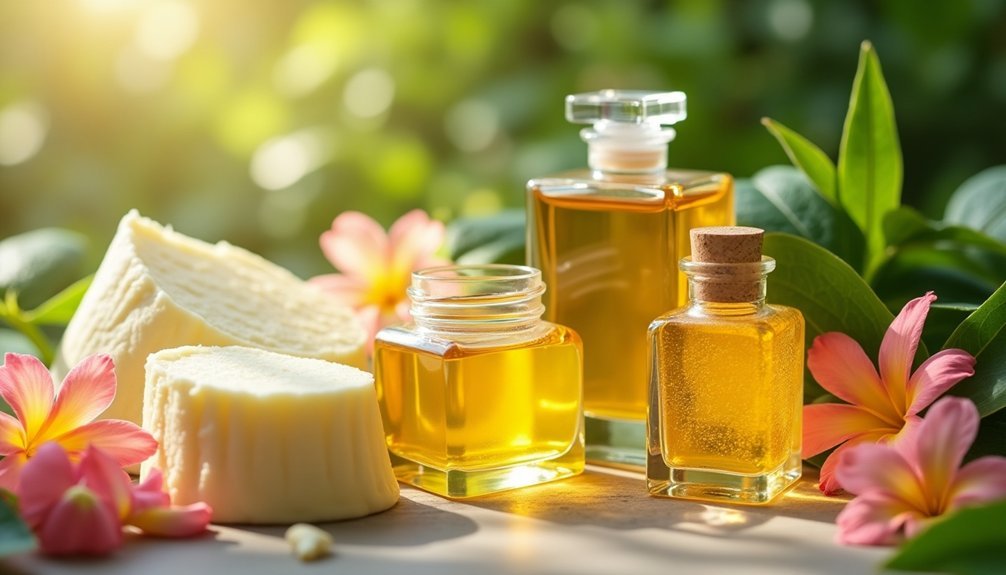



Leave a Reply